The Vancouver Canucks celebrated their 50th season this year and hoped to cap off festivities with their first playoff appearance since 2015.

But, like so many things in recent months, plans changed. With the NHL season suspended until further notice due to the coronavirus pandemic, it’s unclear when the team will be back in action.
With no hockey on the horizon, Global News thought it would be a good time to look back at five decades of team history and build a Canucks dream team.
As part of our goal to build the ultimate Canucks roster, we asked fans to pick four centres, eight wingers, six defencemen, two goalies, and a head coach.
Eligible players must have played at least two seasons for Vancouver. One notable exception is rookie defenceman Quinn Hughes, who demonstrated enough potential in his rookie season to earn a spot on the list.
Global News received more than 65,000 votes from fans. Here are your picks:
Centre
Henrik Sedin
Henrik, and the other guy who looks like him, were the easiest picks to make for this all-star team. He has scored more points and set up more goals than any Canuck in history. He is also the best Canuck of all time in terms of plus/minus at +165.
Interestingly enough, Henrik didn’t really get going offensively until after the NHL’s lockout lost season of 2004-05. Following that year, the league started cracking down on the interference, hooking, and holding that used to be tolerated, and that extra bit of room made all the difference for the Sedins.
Henrik was the first Canuck to win the NHL scoring title with 112 points in 2009-10, and the only Canuck to win the Hart Trophy as league MVP, also in 2010. But, perhaps his most amazing stat is related to his incredible durability, especially considering how often he was used once he became the team’s No. 1 centre. Henrik had 13 seasons where he did not miss a game, and overall he played in 97.8 per cent of all Canucks games between 2000-18. The next stop for him and Daniel should be the Hall Of Fame.
Trevor Linden

It’s hard to think of a Canucks player who has had a deeper connection with fans than Trevor Linden. From the moment he was drafted second overall in 1988 to his retirement 20 years later, Linden’s combination of skill, work ethic, and leadership — he was never one to shirk questions from the media after a bad loss — made him wildly popular.
He scored 30 or more goals in six of his first eight seasons with the Canucks and had a knack for big moments. His high point came in the 1994 Stanley Cup run, where he had 25 points in 24 games, including a pair of goals in the Game 7 loss to the New York Rangers.
One unofficial way to measure his popularity: According to B.C. Vital Statistics Agency, there were no boys in B.C. named Linden prior to 1990. Since then, 729 boys born in the province have received that name, and it’s safe to guess some of that has to do with Captain Canuck.
Elias Pettersson
Thomas Gradin, Patrik Sundstrom, and Elias Pettersson are the three best Swedish-born centres the Canucks have had. (Yes, they had Mats Sundin for 41 games, but that doesn’t count). A strong case could be made for Gradin, Sundstrom, or Pettersson to be on this team — it’s one of those questions that doesn’t really have a wrong answer. Both Gradin and Sundstrom were adept at passing and scoring but Pettersson won the vote on the strength of a Calder Trophy, the popularity with younger fans, and the potential to be a superstar.
Pettersson joining the Canucks is one of those moments where Vancouver’s bad luck in the draft lottery paid off. Had they won the 2017 lottery, they might have gone with someone else, but sitting at fifth overall, Pettersson was the best player available. If the 2017 draft was replayed, Pettersson and Cale Makar would be top two picks, for sure.
One thing Pettersson has that the other aforementioned Swedish stars didn’t is an excellent one-time shot. It could also be argued that J.T. Miller’s better-than-expected season came in large part to playing alongside Pettersson on the top line. Making wingers better is a sure sign of a top-flight centre.
Ryan Kesler

If the Canucks’ all-time roster was a real team, there’s no doubt that Kesler would be a world-class centre capable of shutting down the opposing team’s best players.
Kesler’s best year came in the 2010-11 season when he scored 41 goals and won the Selke Trophy as the NHL’s top defensive forward. He cemented his legacy during the Canucks’ 2011 second-round playoff win over the Nashville Predators where he was the best player on the ice for the entire series.
Kesler left the team in 2014 in an acrimonious trade, but all appears to be forgiven. Earlier this year, he attended the Sedins’ retirement ceremony and told the media prior to the game that he wasn’t sure how he would be received by Canucks fans. He had little to worry about. He received a huge ovation from the crowd, and was visibly moved when he waved at the spectators. It was a fitting return for a Canuck who always played with his heart on his sleeve.
Wingers
Pavel Bure
From his first game with the Canucks, it was clear that Pavel Bure was someone that Vancouver hockey fans had never seen before — an electrifying scorer who had the ability to bring you out of your seats. In his first game, against the Winning Jets in 1991, Bure brought the Pacific Coliseum crowd to its feet with his mad rushes down the ice.
The Russian Rocket’s best work came in the 1994 playoffs, and his Game 7 overtime goal in their opening-round series against the Calgary Flames remains one of the most memorable moments in franchise history.
Bure had impressive numbers in his career — 478 points in 428 games — but it was his breathtaking speed and skill that has left an impression on Vancouver fans.
Daniel Sedin

Henrik was the passer and Daniel was the shooter, scoring more goals than any Canuck in history. A lot of what was said about Henrik applies to Daniel. He also won the NHL scoring title, one year after Henrik did. The only thing Daniel couldn’t do is win the Hart trophy. Daniel finished second to Corey Perry in Hart voting in 2011, but was named the Ted Lindsay Award winner that year. That’s the MVP award that is voted on by the players and not the media.
Daniel was a master at finding open ice to get his shot away, but people forget that he was also a high-level passer. When it comes to all-time assists on the Canucks, Daniel is second only to Henrik, so he was a lot more than just being a trigger man. Plus, these weren’t only assists for Henrik goals, because Henrik didn’t score a lot of goals. His durability is similar to Henrik’s as well. He missed a few more games than his brother but still played in 96 per cent of all Canucks games between 2000 and 2018.
Markus Naslund
The Canucks have made their fair share of bad trades over the years (no Canucks retrospective can be done without the mention of Cam Neely), but the best deal the team ever made was when it picked up Naslund from the Penguins, straight up for Alek Stojanov.
Naslund would become the backbone of the team’s West Coast Express era. His best year came in the 2002-03 season when he finished with 104 points. He ended up second in Hart Trophy voting, trailing only countryman Peter Forsberg, who finished with a league-high 106 points.
A consummate professional, Naslund served as a role model for the Sedins, who also hail from the Swedish city of Örnsköldsvik.
Stan Smyl
With all due respect to Trevor Linden, Smyl is still “Mr. Canuck” in many ways. He has been with Vancouver as a player, assistant coach, farm team coach, and member of the management and scouting teams. He was the first Canuck to have his number retired after 13 seasons as a player who never took a shift off.
“Steamer” was a star with the New Westminster Bruins of the Western Hockey League before the Canucks grabbed him in the third round of the 1978 draft. After an average rookie year, he went eight straight seasons with at least 20 goals each time. He was just over a point a game during Vancouver’s surprising run to the 1982 Stanley Cup finals. Smyl and Henrik Sedin are the only Canucks to have been captain for eight seasons.
Smyl’s contributions can’t be measured just in stats; he delivered offence and grit at the same time. Despite standing five-foot-eight, he was fearless along the boards and didn’t have a problem dropping the gloves to back up his play.
A favourite story from the old timers is how Smyl ran veterans into the boards during his first training camp to get noticed and be respected. It worked. But he didn’t run them into the boards as much as he did opposing players during his entire career with Vancouver.
Todd Bertuzzi
From 2001 to 2003, Bertuzzi was one of the premier power forwards in the NHL, scoring 182 points in 154 games. His chemistry with Brendan Morrison and Markus Naslund made the West Coast Express virtually unstoppable to opposing defences.
In 2002-2003, he was voted on the first all-star team as a right winger. He led the league with 25 power-play goals that season, scoring a lot of those markers from in close, using his strength and determination. The only year he didn’t score at least 20 goals was when he was suspended for the incident with Steve Moore. However, he came back from that to score 25 goals in his final season in Vancouver.
Interestingly, Bertuzzi was involved in trades with two other players to make this all-time team. The Canucks acquired him from the Islanders by sending them Trevor Linden, and they got Roberto Luongo when they traded Bertuzzi to Florida.
Alex Burrows
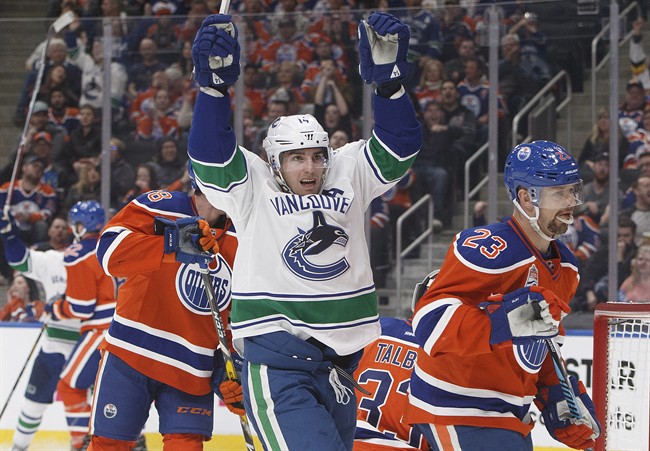
The list of former ball hockey players who make it big in the NHL is a short one, and Alex Burrows tops that list. Burrows became one of the team’s unlikeliest of stars, starting his career as a shut-down forward assigned to stymie opposing forwards and eventually emerging as a goal-scorer in his own right.
He did manage to ruffle some feathers along the way. He feuded with referee Stephane Auger and allegedly bit Patrice Bergeron in Game 1 of the 2011 Stanley Cup finals. He wasn’t suspended for that, and scored the overtime winner the following game.
Alex Mogilny
Since Pat Quinn was overwhelmingly voted as head coach of this dream team, it stands to reason that the most talented player Quinn ever coached should be on this team too. Welcome Alex Mogilny, the man Quinn once said was the most gifted player he’d ever had.
Mogilny arrived in Vancouver via a trade with the Buffalo Sabres where he once scored 76 goals in a single season. His first year with the Canucks (1995-96), was his best — 55 goals and 52 assists. He was supposed to be part of a dynamic duo with fellow Russian Pavel Bure, but Bure only played 15 games that year because of a knee injury suffered in early November.
Mogilny did lead the Canucks in scoring in his second season with 31 goals and 73 points. However, he suffered through injuries and inconsistent play after that and was eventually traded to New Jersey.
Fans saw both sides of him: the brilliant side and the frustrating side where he made you feel he could be giving more. The reputation has followed him wherever he played, and probably is why he still isn’t in the Hockey Hall Of Fame. But, when Mogilny was on his game, he was as talented as Pat Quinn said he was.
Tony Tanti
Caught between the Canucks’ 1982 Stanley Cup run and the Pat Quinn era, it’s easy to forget that Tanti was an elite NHL sniper. Over a span of five seasons starting in 1983, Tanti scored 204 goals. He ranks second all-time in goals per games, behind only Pavel Bure. During his time in Vancouver, he was named the team’s Most Exciting Player five times — a record he shares with Bure.
Defence
Mattias Ohlund
Drafted just after the Canucks lost to the New York Rangers in the 1994 Stanley Cup finals, Ohlund spent three more years in Sweden before arriving in Vancouver in 1997. He nearly signed with the Toronto Maple Leafs before the Canucks matched their offer.
It’s a good thing they did. Ohlund quickly established himself as one of the team’s best defencemen, and until further notice (we’re looking at you, Quinn Hughes), he’s the best blueliner Vancouver has ever drafted.
Ohlund had the size (six-foot-four, 233 pounds) and strength to play in his own zone, with the bonus of some good offensive abilities. He’s second to Alex Edler in career points for Canuck defencemen, but Edler has played 103 more games. Another attribute was his durability. He was able to play in 85 per cent of all Canucks games while on the roster. During his 11 years with Vancouver, his average ice time was 24:59 per game.
Kevin Bieksa

According to legend, Bieksa won over general manager Brian Burke while still in the minors after punching teammate Fedor Fedorov outside a Winnipeg restaurant. Once he was called up to the NHL, he won over teammates with his hard work and sense of humour. He then won over fans with his solid all-around game.
“Juice” ranks seventh in goals among Canucks’ defencemen. No goal was bigger than the double-overtime winner in Game 5 of the 2011 Western Conference finals, which helped send Vancouver to the finals for the first time since 1994.
Alex Edler
Edler, the team’s career leader for points and goals by a defenceman, came to Vancouver as a result of scout Thomas Gradin’s Swedish connections. Edler was not on the NHL’s central scouting list in 2004 because he was playing in a third-tier Swedish league that not many scouts paid attention to. The Canucks did pay attention and drafted him in the third round. He is not only the team’s leader for defencemen in points and goals, but he’s played more games for Vancouver than any defenceman in history.
Much of Edler’s offensive production comes through his work on the power play. Forty-six of his 99 career goals have come on shots from the point with the man-advantage. He’s struggled with injuries during his time with the Canucks, and had a rough 2013-14 when he finished with the worst plus/minus in the league at -39. He bounced back the next year to record a +13. Edler has been a man for all situations no matter whom his coach has been in Vancouver.
Quinn Hughes
This is the only rookie on the all-time team and the only one we allowed to be eligible. That eligibility speaks to both Hughes’ immense talent, and at the risk of diminishing that talent, the fact that the Canucks have (until he came along), failed to draft a talented offensive defencemen in their 50-year history.
The 20-year-old quickly became the quarterback of the Canuck power play, showing the kind of confidence not usually found in rookies. When the 2019-20 season was paused, their power play was fourth-best in the league, and Hughes had a team-leading 22 power-play assists.
Back in the day when this all-time team’s defencemen were drafted, a player of Hughes’ size wouldn’t have been a first-rounder; he might not have been drafted at all. For a long time, NHL scouts and GMs didn’t believe someone less than six feet tall could play defence. But Hughes’ high-level skating, puck control, and ability to see the game helped him overcome any vertical challenges.
Ed Jovanovski
When the Canucks traded Pavel Bure to the Florida Panthers in 1999, the main piece they got in return was Jovanovski, a former No. 1 overall draft pick who became one of the best puck-moving defencemen in franchise history, averaging 47 points a season from 2000 to 2003.
“Jovocop” was a high-risk, high-reward player, who, at six-foot-three and 220 pounds, had the size to play a physical game, but was prone to glaring mistakes that fans were willing to look past because of ability to join the rush.
Jyrki Lumme
The Finnish defenceman arrived in Vancouver in a trade with the Montreal Canadiens in 1990. He would evolve into the bedrock of the Canucks’ blueline during the team’s 1994 Stanley Cup run.
He may not have been the flashiest of players, but he thrived in all aspects of the game. He played in all situations, including the power play and penalty kill, and regularly put up 35 to 55 points a season. He is third all-time in points among Canucks’ defencemen with 321.
Goalies
Kirk McLean
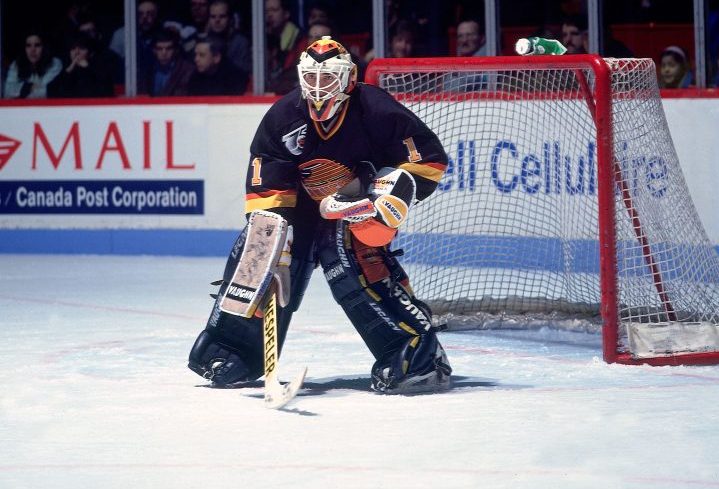
Both of Vancouver’s all-time goalies arrived here via trades. McLean was one of Pat Quinn’s first deals as the team’s GM in 1987, getting him from New Jersey in a trade that also brought in Greg Adams.
McLean was one of the main reasons the Canucks made the Stanley Cup Final of 1994. In fact, had they won the championship, it’s more than likely he would’ve won the Conn Smythe Trophy as playoff MVP. His save percentage for the ’94 post-season was .928 — a remarkable stat for the mid-’90s.
McLean was one of the last classic “standup” netminders, but he wasn’t averse to getting low when needed. He was a workhorse in goal, twice playing more than 60 regular-season games, and two other seasons at more than 50 games. Every teammate he had in Vancouver said he was always the calmest guy on the ice and in the dressing room before games.
Roberto Luongo
When the Canucks traded for Luongo (one of the team’s seemingly endless stream of trades with the Florida Panthers), it felt like a turning point in a franchise. The team had shown promise throughout the 2000s, but failed to coalesce into the type of team built for a deep playoff run. What it needed was an elite goaltender, and when they traded for Luongo, that’s exactly what they got.
During his first season with the Canucks, Luongo won 47 games with a .921 save percentage — good enough to finish second in voting for the Vezina Trophy, Lester B. Pearson Award and Hart Trophy.
He led the team to the 2011 Stanley Cup final and backstopped Canada’s men’s hockey team to a gold medal at the Vancouver 2010 Olympic Winter Games. He won at least 30 games six times for the Canucks — and 40 or more twice.
For all his dominance, Luongo faced his fair share of criticism a hockey market that former GM Brian Burke referred to as a “goalie graveyard.” Some in Vancouver questioned whether he should have been named captain, while others criticized his lack of ability to win the big game.
But his legacy is one that Canucks fans won’t soon forget, and not just because the team is still taking a hit to its salary cap after signing him to a 12-year contract back in 2009.
He finished his career as the team’s all-time leader in wins with 252, and is one of only two goaltenders to take the team to Game 7 of a Stanley Cup final.
Luongo gave Vancouver the chance to be competitive every time he suited up, and that’s something that can’t be said about many Canucks’ goaltenders.
Coach

Pat Quinn may not be the winningest coach in franchise history, but he may the most important. During the early ’90s, the towering Irishman helped build a culture and identity that had been sorely lacking.
Quinn signed a contract to become the president and GM of the Vancouver Canucks back in December 1986 while still under contract with the Los Angeles Kings. He was suspended for doing so and was not able to start in Vancouver until June 1988 or to coach until the 1990-91 season.
It was worth the wait. Once on board, Quinn brought in Kirk McLean, Trevor Linden and Pavel Bure. And once he became head coach in 1991, he took them all the way to the finals in 1994.
Shortly after Quinn’s death in 2014, broadcaster Don Cherry noted that Quinn had an uncanny knack for getting the most out of his players.
“He wasn’t one of those guys with the Xs and Os, but he had the touch. That’s what I think of Pat Quinn, he had the touch.”
— With files from Amy Judd and The Canadian Press
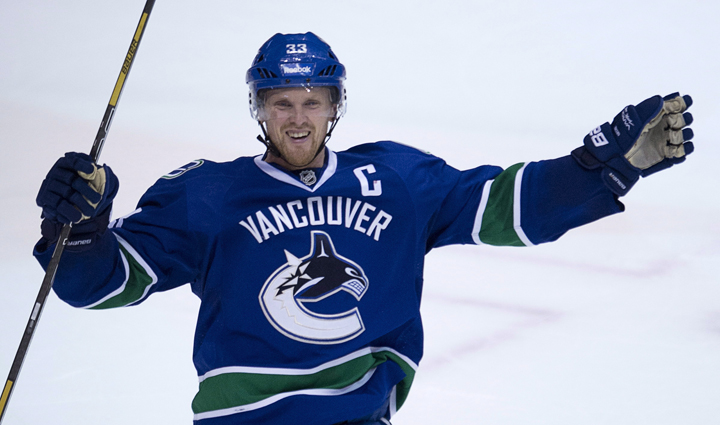


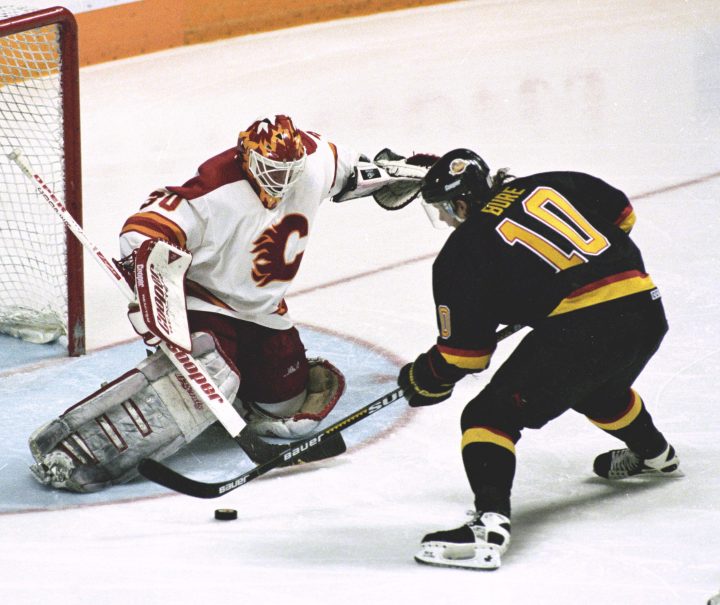












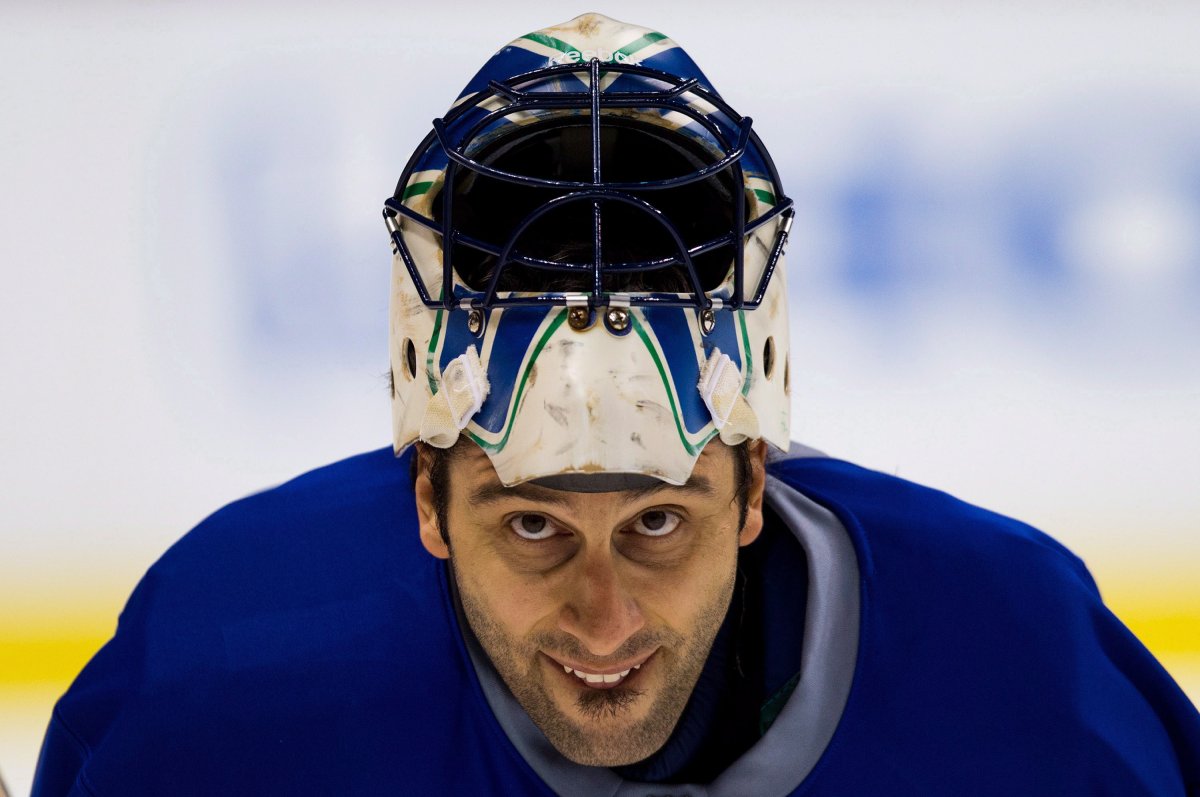
Comments